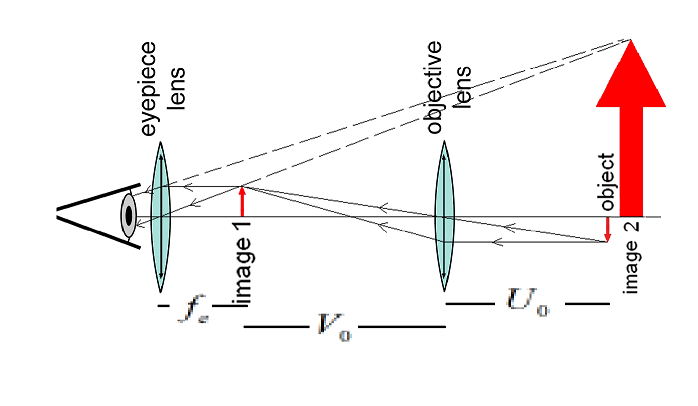Question
Question: The length of a compound microscope is \(14\; cm\) and its magnifying power when the final image is ...
The length of a compound microscope is 14cm and its magnifying power when the final image is formed at a near point is 25. If the focal length of the eyepiece is 5cm. The distance of object form the objective and the focal length of objective lens are:
A.2559cm,3169cm
B.3159cm,2569cm
C.3cm,2cm
D.4cm,1cm
Solution
Compound microscope is a system of lenses which produces enlarged images of the object. It follows lens law and magnification formula as given below. We use D=25cm as the distance till which the relaxed eyes can see .
Formula used:
uo1+vo1=fo1
m=uovo(feD)
Complete answer:
Given that,
Focal length of eyepiece=fe=5cm,
Length of the microscope is L=14cm,
Magnifying power=m=25
Let us consider the ray diagram as shown below:
 Where VO is the distance of the image formed due to the objective lens and UO is the distance due to the object for the objective lens.
Where VO is the distance of the image formed due to the objective lens and UO is the distance due to the object for the objective lens.
Clearly, from the figure we can say that VO+fe=L
⟹VO=L−fe
⟹VO=14−5=9cm
We also know that magnifying power ,m=uovo(feD), where D is the distance a relaxed eye can see.
Now rearranging, we get
m=uovo(feD),
Substituting, we get
⟹UO=259×525
∴UO=59=1.8cm
Now to calculate the focal length of the objective lens , we know from lens formula, uo1+vo1=fo1
⟹591+91=fo1
⟹95+91=fo1
⟹96=fo1
∴fo1=3cm
Hence we get that fo=3cm and UO=1.8cm≈2cm
Thus, option C.3cm,2cm is the correct answer.
Additional Information:
Microscopes are used to magnify objects, the compound microscope has two convex lenses, namely the objective lens and the eyepiece. Both contribute to the final magnification. The objective lens produces a magnification value of about 5×to100× the original size. The object is focused by adjusting the two lenses to produce an enlarged image. The object produces an image with certain magnification by the objective lens with fo , this image now acts a virtual object to the eyepiece with fe which in turn produces a virtual image, which is magnified further. The final image is generally inverted, and can be seen through the normal eyes.
Lens formula is the relationship between the distance of an objectu, distance of imagev and the focal length of the lensf. This law can be used for both concave and convex lenses with appropriate sign conventions. The thickness of the lens is neglected.
Lens formula: v1−u1=f1
And magnification equation is given by M=HeightofobjectHeightofimage=−distanceofobjectdistanceofimage ifM=+ then the image is magnified and if M=− then image is diminished.
But here since two lenses are used the magnification is given by m=uovo(feD).
Note:
The compound microscope has a pair of convex lenses, namely the objective lens and the eyepiece. Both contribute to the final magnification. The object produces an image with certain magnification by the objective lens with fo , this image now acts a virtual object to the eyepiece with fe which in turn produces a virtual image, which is magnified further.
